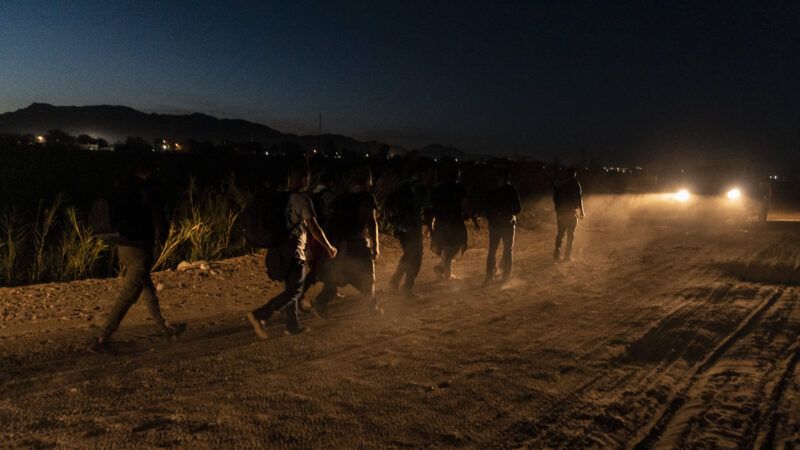Strict U.S. Immigration Laws Leave Migrants Dependent on Human Smugglers
Human smugglers at Mexican border won’t be sought after if migrants can come to the U.S. legally.

Tougher immigration enforcement at the U.S.-Mexico border over the past 50 years has made human smuggling more profitable and resulted in an ever-increasing number of desperate people employing smugglers to reach America. To end human smuggling, U.S. laws and policies must provide significantly greater avenues for individuals to live and work legally in the U.S. and to gain access to human rights protections—including, to the extent possible, before they reach the U.S. border.
The vast majority of activity on the Southern border involves human smuggling—someone paying to be taken across the country's border. This is different than human trafficking, which is far less common.
Former President Donald Trump and current Homeland Security Secretary Alejandro Mayorkas agree that human smugglers are bad. Yet neither succeeded in limiting human smuggling or illegal border crossings.
Despite tougher rhetoric and somewhat harsher policies under the Trump administration, apprehensions at the Southwest border, a proxy for illegal entry, increased by more than 100 percent between FY 2016 and FY 2019 (from 408,870 to 851,508). Apprehensions dropped in March 2020 because of the pandemic but by August and September 2020 returned to the approximate level of illegal entry during those same months in FY 2019. In FY 2021, a little over nine months of which included the Biden presidency, apprehensions reached a nominal high of 1.66 million. Border Patrol agents have used Title 42 to expel people without further processing, causing many would-be immigrants to attempt multiple crossings, making historical comparisons difficult.
Human smuggling is a dangerous, booming business. Drug cartels, while they don't control smugglers, earn money by capitalizing on the misery of those smuggled. Cartels charge tolls for smugglers who move through their territory and extort money by kidnapping and demanding ransom from victims' relatives in the United States.
Increased enforcement has encouraged virtually every unauthorized immigrant to use a smuggler. The Department of Homeland Security (DHS) notes that "smuggler usage rates have increased steadily over the last 5 decades," with the percentage of migrants using smugglers rising from 40 percent to 50 percent in the 1970s to 95 percent by 2006, coinciding with increased federal spending on immigration enforcement.
U.S. law enforcement also concedes human smugglers are service providers. "Migrants will only tolerate higher fees to the extent that smugglers provide an essential and successful service," according to a 2018 DHS report. "Smugglers also compete to attract customers by offering their services at the lowest profitable rate, so higher fees indicate rising costs to smugglers." There is no evidence U.S. enforcement will ever make smuggling prices too high for migrants.
Arrest one smuggler and another one will pop up. It's a pretty low bar to become a human smuggler—almost anyone from south of the border can become one. "Smuggling markets tend to possess low barriers to entry and remarkably similar organizational arrangements in all the main smuggling routes in the world," University of Cambridge professor of criminology and complex networks Paolo Campana wrote. The Washington Post even profiled a Mexican teenager who earned money for years as a smuggler. He was never prosecuted due to his age.
There is one way to make human smuggling drop significantly or even largely disappear—allow those who now pay smugglers instead to obtain a legal visa to work in the United States. Apprehensions at the border dropped 95 percent between 1953 to 1959 when the Immigration and Naturalization Service liberalized the entry of Mexican farmworkers via the Bracero program. Today, establishing a new work visa with sufficient annual allocations, expanding the H-2B visa category, and negotiating bilateral agreements between the United States and Mexico, as well as countries in Central America, would increase legal avenues to work and eliminate the need for individuals to pay smugglers.
Expanding opportunities for individuals to apply for protection in their home countries—via refugee interviews at consulates and circuit rides—would also make it less likely for people to pay smugglers to reach the United States. Migrants should be able to apply for refugee status from their home country. That way they don't resort to human smugglers just to be denied refugee status at the border. And, in that case, an opportunity to obtain a work visa at a consulate and travel legally to the U.S. would be a good alternative for many individuals and their families.
Human smugglers would be happy to see the U.S. keep the same immigration policies that have allowed their business to flourish over the last 50 years. Making legal immigration an easier avenue will create a safer alternative for migrants.

Show Comments (199)